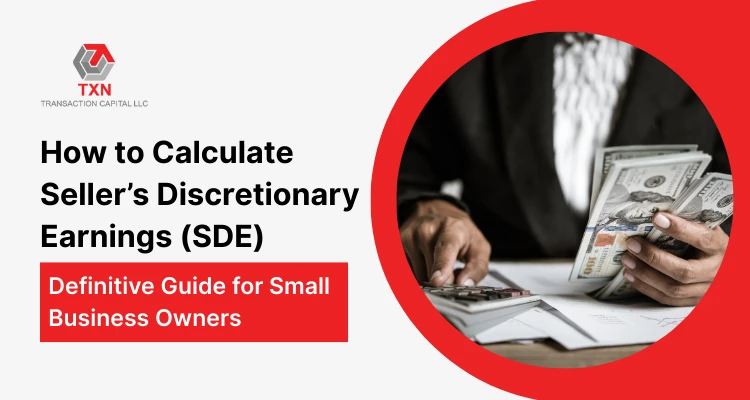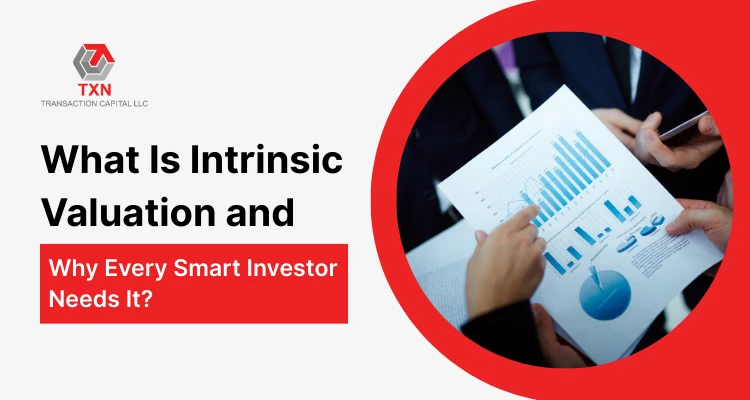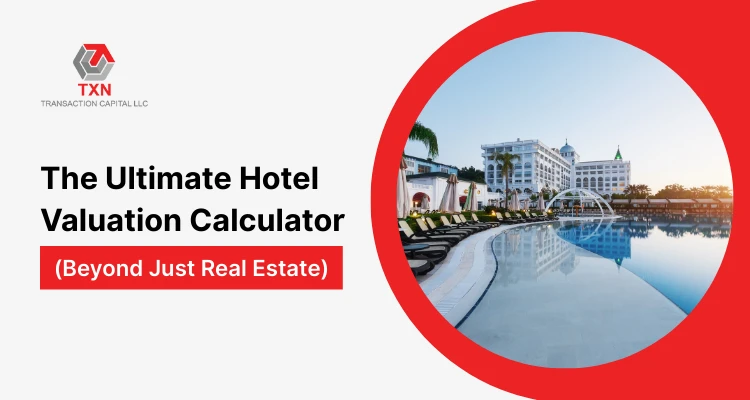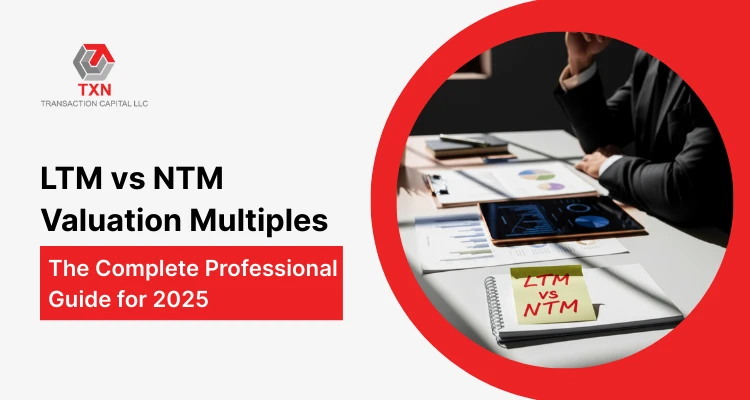How to Calculate Seller’s Discretionary Earnings (SDE): The Definitive Guide for Small Business Owners

Want to discover your business's real worth? For countless small and mid-sized business owners, the fundamental question "What is my business worth?" emerges only during critical moments—when preparing to sell, seeking loan approval, or attracting potential investors. However, comprehending your business's value well ahead of time empowers you to negotiate confidently, monitor genuine growth, and strategize effectively.
When evaluating owner-operated businesses (typically those generating under ~$5M in revenue), the most critical metric isn't EBITDA, net income, or even total revenue. It's Seller's Discretionary Earnings (SDE).
SDE demonstrates the genuine financial advantage to an owner-operator, delivering a transparent picture of what a prospective owner could realistically expect to earn annually. It serves as the cornerstone for small business valuations and is extensively utilized by brokers, purchasers, and lending institutions.
Key Takeaways
- SDE stands as the #1 metric for valuing owner-operated businesses generating <$5M revenue
- It encompasses net profit plus owner salary, benefits, discretionary spending, and one-time adjustments
- Purchasers utilize SDE multiples (typically 2–4×) to establish business value
- Clean, well-documented SDE creates trust with buyers and lenders—resulting in higher valuations
- Use SDE rather than EBITDA if you actively manage your business; EBITDA works better for professionally managed companies
What Is Seller's Discretionary Earnings (SDE)?
Seller's Discretionary Earnings measures the complete financial benefit a single, full-time owner extracts from their business operations. It's the gold standard metric for valuing owner-operated companies generating under $5 million in annual revenue.
SDE goes beyond simple net profit by including:
- Owner's total compensation package
- Personal expenses run through the business
- One-time or unusual costs that won't recur
- Non-cash expenses like depreciation
- Interest payments (since financing structures vary)
Alternative names for SDE include:
- Adjusted Cash Flow
- Owner's Benefit
- Recast Earnings
Why is SDE crucial for small businesses? Traditional metrics like net income often understate the true economic value of owning a small business. Owners frequently mix personal and business expenses or pay themselves below-market salaries to minimize taxes.
Why SDE Beats Net Profit for Small Business Valuations
Net profit alone frequently understates the authentic economic benefit of owning a small business. Owners regularly process personal expenses through the company or establish compensation that's above (or below) market levels. Without adjusting for these factors, a buyer observes distorted results.
For example:
- A landscaping business displays net profit of $60,000
- However, the owner also compensates themselves $75,000, operates a company-funded vehicle ($8,000), and covered a one-time legal expense ($5,000)
Adjusted SDE = $60,000 + $75,000 + $8,000 + $5,000 = $148,000
This paints a dramatically different picture for potential buyers.
SDE vs. EBITDA: Understanding the Difference
| Aspect | SDE | EBITDA |
|---|---|---|
| Best For | Owner-operated businesses (Main Street, <$5M revenue) | Larger, professionally managed firms |
| Owner Salary | Added back (one full-time owner) | Not added back |
| Discretionary Items | Included (personal travel, auto, etc.) | Excluded |
| Purpose | Shows what one owner can reasonably take home | Shows performance independent of ownership |
| Valuation Use | Small business sales, SBA lending, individual buyers | Private equity, institutional buyers |
Rule of thumb:
- If you manage the business day-to-day → Use SDE
- If the business operates without you → Use EBITDA
The Complete SDE Formula
SDE = Net Profit (or EBT)
+ One Owner's Compensation (normalized)
+ Interest
+ Depreciation & Amortization
+ Discretionary Expenses
+ Non-Recurring/One-Time Expenses
- Non-Operating Income
± Normalizations (replacement salaries, related-party rent, etc.)
Each component serves a specific purpose in creating a normalized earnings picture that buyers can trust and underwriters can approve.
Step-by-Step: How to Calculate SDE Accurately
Step 1: Start With Pre-Tax Net Income
Begin with your business's net profit before taxes from your P&L statement or tax return. This baseline figure represents your business's core profitability before owner-specific adjustments.
Pro tip: Use your most recent 12-month period for the most accurate current valuation but have 2-3 years of historical data ready for trend analysis.
Step 2: Add Back Owner Compensation
Include the full compensation package for one working owner:
- Base salary or draws
- Payroll taxes and benefits
- Health insurance premiums
- Retirement contributions
Important limitation: Only add back compensation for one full-time owner-operator. If multiple owners work in the business, subtract market-rate replacement costs for additional owners.
Step 3: Add Back Financing and Non-Cash Costs
These items get added back because they vary based on ownership structure:
- Interest expense on business loans
- Depreciation on equipment and assets
- Amortization of intangible assets
Why add these back? New owners will have different financing arrangements and depreciation schedules, so these costs don't reflect true operational earnings.
Step 4: Include Discretionary Business Expenses
Add back personal expenses legitimately run through the business:
- Auto expenses for personal use
- Personal cell phone bills
- Owner-only meals and entertainment
- Personal travel expenses
- Charitable donations made by the business
Documentation requirement: Every discretionary add-back needs supporting receipts and clear business justification.
Step 5: Account for Non-Recurring Expenses
One-time costs that won't repeat for new owners:
- Legal settlement payments
- Emergency equipment repairs
- Consultant fees for specific projects
- Unusual insurance claims
Buyer scrutiny: Be prepared to justify why each expense truly won't recur—buyers are skeptical of too many "one-time" items.
Step 6: Subtract Non-Operating Income
Remove income sources that won't transfer to new owners:
- Insurance settlement proceeds
- Asset sale gains unrelated to operations
- Investment income from business cash
- Rental income from unrelated properties
Step 7: Make Normalizing Adjustments
Adjust for below-market or above-market arrangements:
- Related-party rent (adjust to market rates)
- Family member salaries (normalize to market wages)
- Unusual supplier arrangements
- Below-market customer contracts
Real-World SDE Calculation Examples
Example 1: Small Restaurant
Starting financials:
- Net Profit (Pre-Tax): $120,000
- Owner Salary: $80,000
- Interest: $10,000
- Depreciation: $7,000
- Discretionary Expenses: $12,000 (auto + personal travel)
- One-Time Expense: $8,000 (legal fees)
SDE = $120,000 + $80,000 + $10,000 + $7,000 + $12,000 + $8,000 = $237,000
Example 2: HVAC Business
Starting financials:
- Pre-Tax Income: $275,000
- Owner Salary: $85,000
- Interest: $12,000
- Depreciation & Amortization: $18,000
- Owner Perks: $22,000
- One-Time Renovation: $8,000
SDE = $420,000
A buyer can now value the company by applying a multiple (say 3×) → $1.26M.
Example 3: Joe's Auto Repair
Starting financials:
- Net Income: $75,000
- Depreciation & Amortization: $10,000
- Interest: $5,000
- One-Time Expense: $2,500
- Owner's Salary + Expenses: $68,000
- Non-Discretionary Owner Rent: −$12,000
SDE = $138,500
At an industry multiple of 2.8× → Valuation ≈ $388,000
What Expenses Can You Legitimately Add Back?
Clearly Acceptable Add-Backs
These adjustments are universally accepted by buyers and lenders:
- One owner's complete compensation package
- All depreciation and amortization
- Interest expense on business debt
- Documented one-time legal or professional fees
- Personal use of company vehicles
- Owner-specific insurance policies
Questionable Add-Backs Requiring Strong Justification
These require thorough documentation and clear business rationale:
- Mixed-use travel expenses (separate personal vs. business portions)
- Entertainment expenses beyond normal business needs
- Charitable contributions made through the business
- Home office expenses for owner's residence
- Professional development with primarily personal benefit
- Family cell phone bills paid by business
Completely Unacceptable Add-Backs
Never include these in legitimate SDE calculations:
- Regular employee salaries for non-owners
- Ongoing marketing and advertising expenses
- Normal maintenance and repairs
- Multiple owner salaries beyond one full-time equivalent
- Expenses that directly benefit ongoing business operations
- Recurring utility bills and operational costs
Common SDE Calculation Mistakes to Avoid
1. Overstating “One-Time” Costs
Many owners inflate SDE by classifying recurring expenses as one-time costs. Serious buyers will immediately flag this and adjust the numbers, reducing trust in your financials.
2. Ignoring Owner Replacement Salaries
If your business relies on multiple owners, you must factor in the fair market salary required to replace them. Skipping this adjustment will lead to inflated SDE and lower credibility with buyers.
3. Lack of Documentation
Every add-back must be supported with receipts, invoices, or payroll records. Without clear documentation, buyers and lenders may reject your adjustments outright.
4. Forgetting CapEx and Working Capital
Capital expenditures (CapEx) and working capital needs are modeled separately by buyers. Failing to account for these can make your business look stronger than it actually is, leading to valuation disputes.
5. Mixing Personal and Business Finances
Blurring the line between personal and business expenses weakens financial transparency. This not only reduces buyer confidence but can also lower your valuation multiples.
How SDE Translates Into Business Value
Once you've calculated accurate SDE, valuation becomes a multiplication exercise. Business brokers and buyers apply industry-specific multiples to determine market value.
Typical SDE Multiples by Industry
Lower multiples (1.5x - 2.5x):
- Small retail businesses
- Seasonal operations
- Location-dependent services
Medium multiples (2.0x - 3.0x):
- Restaurants and food service
- Salons and personal care services
- Traditional service businesses
Higher multiples (2.5x - 4.0x):
- Recurring revenue businesses
- Professional services firms
- E-commerce with established systems
- Technology-enabled services
Valuation example: SDE of $250,000 × 3.2x multiple = $800,000 business value
How to Maximize Your SDE Before Selling
Strategy 1: Clean Up Your Financial Records
Start separating personal and business expenses 18-24 months before selling. This builds credibility and makes add-back justifications stronger.
Action steps:
- Open separate credit cards for personal use
- Stop running personal expenses through the business
- Document any remaining mixed-use expenses clearly
Strategy 2: Optimize Owner Compensation
Ensure your salary reflects market rates for similar roles. Extremely high or low compensation raises buyer concerns.
Benchmark research: Use industry surveys and local employment data to justify your compensation level.
Strategy 3: Build Operational Independence
Reduce business dependency on your daily involvement:
- Document all processes and procedures
- Train and empower key employees
- Create management systems that work without you
Impact: Less owner-dependent businesses command higher multiples and attract more buyers.
Strategy 4: Focus on Recurring Revenue
Prioritize revenue sources that provide predictable monthly income:
- Service contracts with annual terms
- Subscription-based offerings
- Maintenance agreements
- Long-term client relationships
Why it matters: Recurring revenue increases both SDE multiples and buyer confidence.
Strategy 5: Improve Profit Margins
Focus on operational efficiency and cost optimization:
- Negotiate better terms with key suppliers
- Eliminate unnecessary overhead expenses
- Streamline operations to reduce waste
- Implement technology to improve productivity
- Review and optimize pricing strategies
Timeline: Start margin improvement initiatives 2-3 years before planned sale for maximum impact.
Strategy 6: Plan Well in Advance
Begin SDE optimization 24-36 months before selling:
- Establish clean financial record-keeping systems
- Separate all personal expenses from business operations
- Build consistent, trackable performance metrics
- Create comprehensive operational documentation
When to Use Professional Business Valuation Services
While basic SDE calculations help with planning, certified valuations provide the credibility needed for serious transactions.
Situations Requiring Professional Valuations
- SBA loan applications: Lenders require certified business valuations meeting specific standards.
- Business sale preparation: Professional valuations identify value drivers and optimization opportunities.
- Partnership disputes: Court-acceptable valuations require certified appraiser credentials.
- Estate planning: Gift and estate tax valuations must meet IRS requirements for accuracy and compliance.
- Tax compliance matters: Professional valuations provide audit defense for significant transactions.
Why Choose Certified Valuation Professionals
At Transaction Capital LLC, our team holds multiple industry certifications:
- ABV® (Accredited in Business Valuation) from AICPA
- ASA (Accredited Senior Appraiser) credentials
- CVA® (Certified Valuation Analyst) from NACVA
- MRICS from Royal Institution of Chartered Surveyers
Our experience includes over 2,500 completed valuations across 35+ industries, with expertise in startup valuation services, business valuation services, and specialized areas like ESOP valuation services.
Advanced SDE Considerations for Complex Businesses
Multiple Revenue Streams
For businesses with diverse income sources, calculate SDE for core operations separately from passive income streams. This provides cleaner comparables for valuation purposes.
Seasonal Business Adjustments
Highly seasonal businesses require careful normalization:
- Use rolling 12-month periods instead of calendar years
- Adjust for unusual weather or market conditions
- Consider multiple years of data for trend analysis
Family Business Complexities
Family-owned businesses often have unique SDE challenges:
- Multiple family members on payroll
- Related-party transactions
- Mixed personal and business real estate
Solution approach: Work with experienced valuation professionals who understand family business dynamics and can make appropriate normalizations.
Real-World Mini Case Study: Joe’s Auto Repair
Let’s break down how Seller’s Discretionary Earnings (SDE) is calculated using a small business example.
Joe’s Auto Repair Financials:
- Net Income: $75,000
- Depreciation & Amortization: $10,000
- Interest: $5,000
- One-Time Expense: $2,500
- Owner’s Salary & Perks: $68,000
- Non-Discretionary Owner Rent: −$12,000
SDE Calculation: When you add back the relevant expenses and adjustments, Joe’s Auto Repair shows an SDE of $138,500.
Business Valuation: Using an industry multiple of 2.8×, the estimated valuation comes out to approximately $388,000.
Conclusion: Master SDE to Maximize Business Value
Understanding how to calculate Seller's Discretionary Earnings gives you powerful insights into your business's true worth. Whether you're planning to sell, seeking financing, or simply want to track value creation, accurate SDE analysis forms the foundation of smart business decisions.
The key to success lies in preparation and documentation. Start cleaning up your financials, separating personal expenses, and building systems that reduce owner dependency well before you need a valuation.
Remember: SDE calculation is both art and science. While the formula is straightforward, proper application requires understanding buyer psychology, industry standards, and regulatory requirements.
Ready to Discover Your Business's True Value?
Transaction Capital LLC specializes in certified business valuations for small and medium-sized businesses. Our team of credentialed professionals (ABV®, ASA, CVA®, MRICS) has completed over 2,500 valuations across dozens of industries.
We offer comprehensive valuation services including:
- Business valuation services for all transaction types
- Startup valuation services for growing companies
- ESOP valuation services for employee ownership transitions
- Gift & estate tax valuation services for family transfers
- Intangible valuation for intellectual property assets
- SBA 7a valuations for loan applications
- Equity research and fairness opinions
Get started with a free 15-minute consultation to discuss your valuation needs and timeline. Our audit-ready reports are typically delivered within 2-5 business days. Don't just calculate SDE—maximize it strategically and unlock your business's full potential value.




